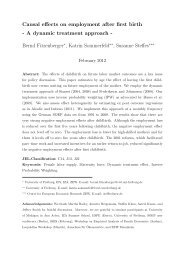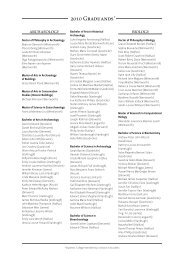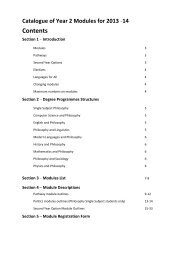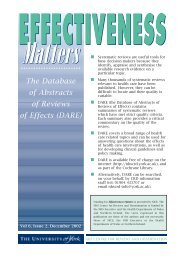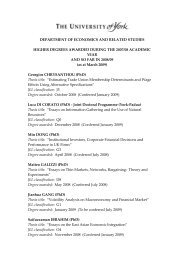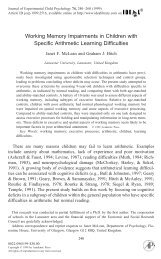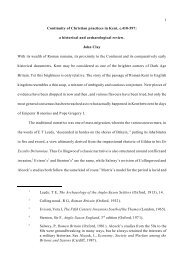GeloriniPhD (PDF , 6973kb) - University of York
GeloriniPhD (PDF , 6973kb) - University of York
GeloriniPhD (PDF , 6973kb) - University of York
You also want an ePaper? Increase the reach of your titles
YUMPU automatically turns print PDFs into web optimized ePapers that Google loves.
. 27 .<br />
INTRODUCTION<br />
metallurgy mainly due to the emergence <strong>of</strong> trade networks, though foraging and traditional stone-tool technologies<br />
continued to prevail (Stahl, 2004). For decades, the spread <strong>of</strong> early farming and knowledge <strong>of</strong> iron working across sub-<br />
Saharan Africa (~500 BC-500 AD) has been regarded as having been conterminous with the expansion <strong>of</strong> Bantu-speaking<br />
farmers (e.g., Posnansky, 1968; Schoenbrun, 1993; Robertshaw and Taylor, 2000). However, it becomes increasingly<br />
clear that these processes <strong>of</strong> demographic, linguistic, economic and technological change may have developed<br />
independently <strong>of</strong> one another, probably through complex multi-cultural interactions at different time scales (Lane et al.,<br />
2007). At present, the debate about the origin and timing <strong>of</strong> first iron metallurgy in the Great Lakes region prior to the<br />
Bantu migration is ongoing (e.g., Alpern, 2005; Killick, 2009), however the idee fixe <strong>of</strong> an exclusively Bantu-related iron<br />
work introduction between ~800-400 BC remains hinted through the discussions. This example <strong>of</strong> begging the question<br />
is possible because <strong>of</strong> the limited multi-proxy archaeological data and poorly constrained radiometric dating, together<br />
with palaeoenvironmental hints <strong>of</strong> increasing agricultural activity from that period on (e.g., Schoenbrun, 1993; Sutton,<br />
1995; Jolly et al., 1997; Taylor et al., 2000; Killick, 2009), as if by evidence <strong>of</strong> human activity fairly completing the historical<br />
picture. Nothing is farther from the truth: methodological deficiencies can unfortunately not be ignored and need to be<br />
regarded from a proper perspective, totally unrestrained from apriorisms. It can surely be argued that in tropical Africa<br />
the distinction between natural and cultural landscapes is not evident, because <strong>of</strong> significant climate-driven vegetation<br />
dynamics at both short and longer time scales, and relative mobility <strong>of</strong> indigenous people in response to the impacts <strong>of</strong><br />
this climate change on land and water resources.<br />
How indigenous African people have interacted with climate-driven environmental changes and have modified<br />
landscapes to their food demands, has been dealt with in many reviews on the political, social, economic and cultural<br />
dimensions <strong>of</strong> East African pre-colonial and colonial societies (e.g., Smith, 1992; Connah, 1997; Schmidt, 1997; Robertshaw<br />
and Taylor, 2000; Taylor et al., 2000; Robertshaw et al., 2004; Stahl, 2004). Archaeological surveys have indicated that<br />
substantial occupation <strong>of</strong> the Interlacustrine area began from the ninth century AD, coeval with a pre-Medieval Warm<br />
Period <strong>of</strong> elevated rainfall (Robertshaw and Taylor, 2000). In the following centuries <strong>of</strong> region-wide drought, distinct<br />
subsistence patterns such as agro- and transhumant pastoralism developed, facilitating the occupation <strong>of</strong> dry (marginal)<br />
grasslands. Livestock keeping and crop cultivation were initially practiced in the same households, but soon became<br />
subject to class divergence (Stahl, 2004). Due to the emergence <strong>of</strong> long-distance trade networks (e.g., ivory, salt, iron,<br />
shell beads) elites started to consolidate power, leading to small chiefdoms (e.g., Ntusi and Munsa) (Robertshaw and<br />
Taylor, 2000). Wetter conditions after ~1250 AD resulted in increasing agricultural success (e.g., Engaruka; Holmgren and<br />
Öberg, 2006) and political stability (e.g., Bigo, Kibengo, Kibiro and Munsa). Around 1700 AD, however, major political<br />
economic changes occurred across the region, including the fall <strong>of</strong> the capital at Munsa (Robertshaw and Taylor, 2000).<br />
Nucleated villages were replaced by dispersed homesteads, and stratification between pastoral nobility and agricultural<br />
peasantry became more apparent in the Great Lakes region (Reid, 1996; Stahl, 2004; Robertshaw, 2010), a pattern that<br />
has mainly persisted into colonial and recent times.<br />
Unfortunately, much <strong>of</strong> East African history is mainly reconstructed from scarce archaeological remains and historical<br />
sources affiliated to elite groups during pre-colonial and colonial times. Archaeological records from pre-colonial<br />
periods (prior ~1880 AD) remain lacking, partly due to low archaeological visibility <strong>of</strong> the temporary settlements<br />
occupied by pastoralists, leaving few materials behind once the open-air site is abandoned (Robertshaw, 1978; Banning<br />
and Kohler-Rollefson, 1992). Also the difficulty <strong>of</strong> distinguishing between hunter-gatherer and pastoral archaeological<br />
sites causes a major interpretive problem in studies <strong>of</strong> prehistoric Africa (Shahack-Gross et al., 2003; Mutundu, 2010).<br />
Besides, most archaeological sites are located away from palaeoecological reconstruction sites, making it difficult to<br />
relate observed changes in habitat directly to human patterns <strong>of</strong> resource use (Lane, 2010). Historical written sources<br />
from pre-colonial times are rare, making historiographical support <strong>of</strong> current culture-historical hypotheses inadequate.<br />
The few extant written sources, which frequently served the interests <strong>of</strong> the colonial state and European settler colonies,



